There was a time when buying enterprise software suites – monolithic platforms that could do it all across teams and departments – was the thing to do.
You’d only need to worry about one vendor. You only had one bill to pay (although it was usually huge), and everyone you talked to outside of your organization was either using the same suite, or one of two or three other competitors.
But times have changed, and so has the technology space.
Today, innovation is happening at a rapid pace, and large-scale enterprise suites simply can’t keep up to their best-of-breed software counterparts when it comes to performance, flexibility and development.

Often these suites are built through software acquisition. This leads to questions about software quality (not all software is built, or integrated, equally), and the parent company’s ability to support and develop a product they aren’t as familiar with.
Still, many organizations are locked in with these software giants and are paying the price: siloed enterprise tech stacks, long development cycles, and high costs for little return.
That’s why more and more companies are moving away from enterprise suites and embracing a new way of building their tech ecosystem.
What is the MACH Alliance?
The MACH Alliance is a non-profit organization on a mission to “future proof enterprise technology and propel current and future digital experiences.” The group advocates for an open and best-of-breed enterprise technology ecosystem, one that is “agile, nimble and always up to date.”
The idea is relatively straightforward. According to its website, MACH technologies are:
- Microservices based: Software built with ‘modular’ services or functionalities to increase flexibility, rather than large code blocks with sometimes unnecessary features.
- API-first: Software that focuses on its core purpose, while providing ways to connect to other essential tools in the tech stack.
- Cloud-native: SaaS that leverages the cloud, beyond storage and hosting, including elastic scaling and automatically updating.
- Headless: Software that does not have a front end, and can be integrated with other technologies into a front-end application in order to create a custom system.
Single vendor technology platforms are committed to doing one thing, and doing it very well. They pour all their resources and innovation into that one solution in order to maximize its value to the buyer.
On the other hand, enterprise software suites, which are a collection of many different solutions rolled into a single product, simply can’t do the same. They’ll often focus resources into their top-selling module, for example, and leave the less popular, but still essential, modules to fade into obsolescence. Or, they’ll be loaded with features you don’t really need. Often, it’s both.
The principles of the MACH framework also address the oft-quoted benefit of the enterprise suite: having a single connected collection of solutions. By building technology that is API-first, it allows for connectivity between platforms, enabling a truly integrated tech stack that leverages only best-in-breed technologies – and gives you the flexibility to swap out any one technology for an alternative without impacting the rest of the organization.
And of course, these MACH tech stacks are able to stay on the leading edge of innovation because the technologies are cloud-native, meaning they can be updated easily and frequently without interruption of service.
By advocating for the MACH framework, the Alliance is raising awareness of these technology platforms as desirable alternatives to inflexible and dated enterprise software suites.
Data is a foundational element of DAM success. Learn how to set up your DAM to deliver key insights in our webinar DAM Data 101.
Tenovos and the MACH framework
Traditional digital asset management platforms act as a content repository or library, storing assets in perpetuity and hoping users find them when they’re needed. This is an outdated approach to DAM. There are exciting, innovative developments happening in the space, but these large vendors, where DAM is only one small part of their larger software suite, are spending their resources elsewhere.
At Tenovos, we recognize that brand teams are looking for a cohesive suite of marketing technologies, of which DAM platforms are foundational, that allow them to manage the entire asset lifecycle, from ideation to distribution. These technologies must be intimately connected to allow for assets, content, and data to flow effortlessly between them. That’s why we’ve built our platform firmly upon the MACH framework.
In line with The MACH Alliance, our innovative approach to DAM calls for an integrated, flexible technology ecosystem.
- We leverage microservices to develop, deliver, and update the functionalities our users need.
- Our platform is cloud-native, allowing us not only to leverage cloud technology to maximize performance, but also to deploy frequent updates as our team adds more innovative functionality into the product.
- And lastly, we are an API-first technology that seamlessly integrates with enterprise tech stacks to feed essential assets and data into the tech ecosystem.
The future of enterprise technology
Whether you’re evaluating a new DAM platform, or trying to sort out what a tech ecosystem might look like at your organization, remember the future is changing every day. Companies like Tenovos are committed to innovation, and we focus on delivering the best-in-breed technology our clients need to perform in this rapidly changing business landscape.
The MACH Alliance, and companies like Tenovos who are committed to their principles, promise the delivery of a future-proof, innovative, modern and interconnected enterprise technology ecosystem. No enterprise suite can say the same.
Learn more at www.tenovos.com/integrations.



